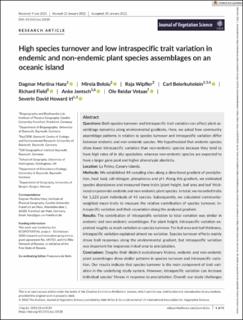High species turnover and low intraspecific trait variation in endemic and non-endemic plant species assemblages on an oceanic island
Hanz, Dagmar Martina; Beloiu, Mirela; Wipfler, Raja; Beierkuhnlein, Carl; Field, Richard; Jentsch, Anke; Vetaas, Ole Reidar; Irl, Severin David Howard
Journal article, Peer reviewed
Published version

Åpne
Permanent lenke
https://hdl.handle.net/11250/3055057Utgivelsesdato
2022Metadata
Vis full innførselSamlinger
- Department of Geography [634]
- Registrations from Cristin [9791]
Sammendrag
Questions
Both species turnover and intraspecific trait variation can affect plant assemblage dynamics along environmental gradients. Here, we asked how community assemblage patterns in relation to species turnover and intraspecific variation differ between endemic and non-endemic species. We hypothesized that endemic species show lower intraspecific variation than non-endemic species because they tend to have high rates of in situ speciation, whereas non-endemic species are expected to have a larger gene pool and higher phenotypic plasticity.
Location
La Palma, Canary Islands.
Methods
We established 44 sampling sites along a directional gradient of precipitation, heat load, soil nitrogen, phosphorus and pH. Along this gradient, we estimated species abundances and measured three traits (plant height, leaf area and leaf thickness) on perennial endemic and non-endemic plant species. In total, we recorded traits for 1,223 plant individuals of 43 species. Subsequently, we calculated community-weighted mean traits to measure the relative contribution of species turnover, intraspecific variation and their covariation along the analysed gradient.
Results
The contribution of intraspecific variation to total variation was similar in endemic and non-endemic assemblages. For plant height, intraspecific variation explained roughly as much variation as species turnover. For leaf area and leaf thickness, intraspecific variation explained almost no variation. Species turnover effects mainly drove trait responses along the environmental gradient, but intraspecific variation was important for responses in leaf area to precipitation.
Conclusions
Despite their distinct evolutionary history, endemic and non-endemic plant assemblages show similar patterns in species turnover and intraspecific variation. Our results indicate that species turnover is the main component of trait variation in the underlying study system. However, intraspecific variation can increase individual species’ fitness in response to precipitation. Overall, our study challenges the theory that intraspecific trait variation is more important for the establishment of non-endemic species compared with endemic species.
